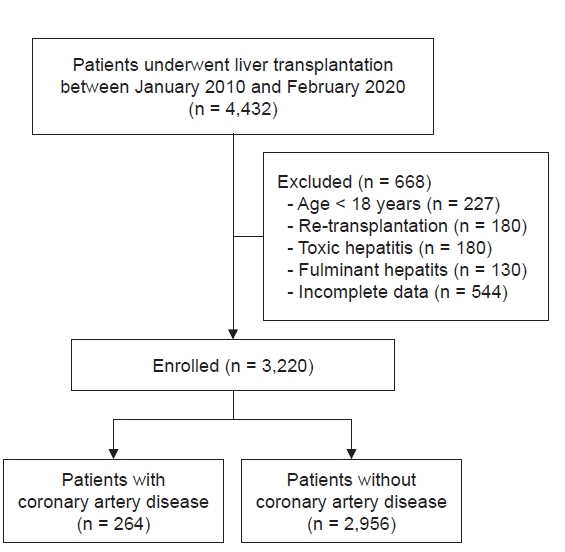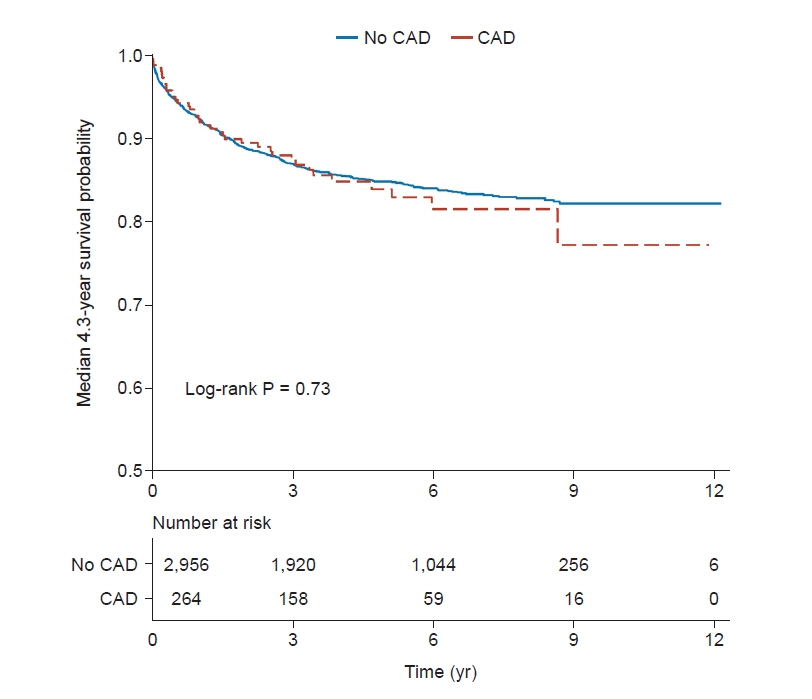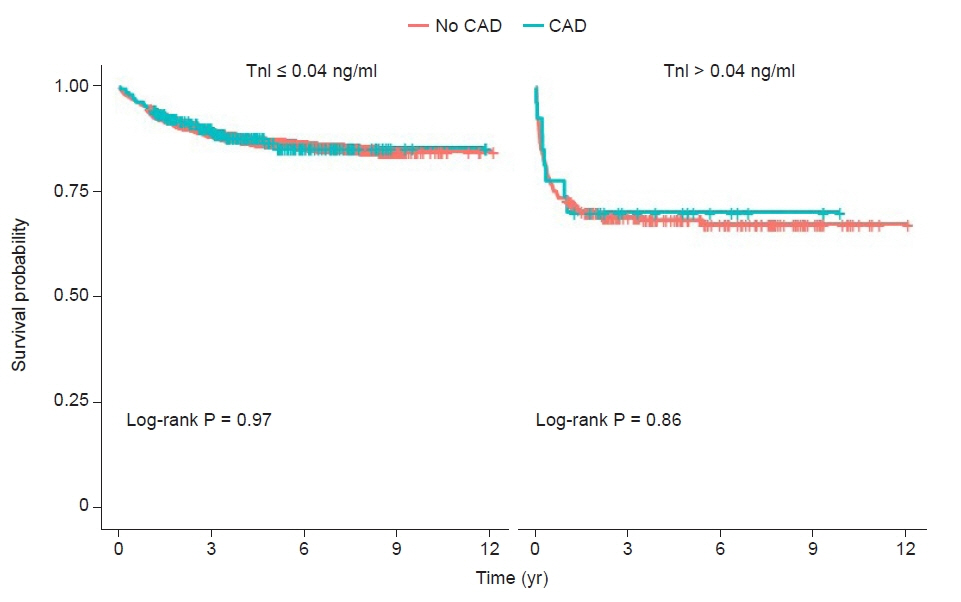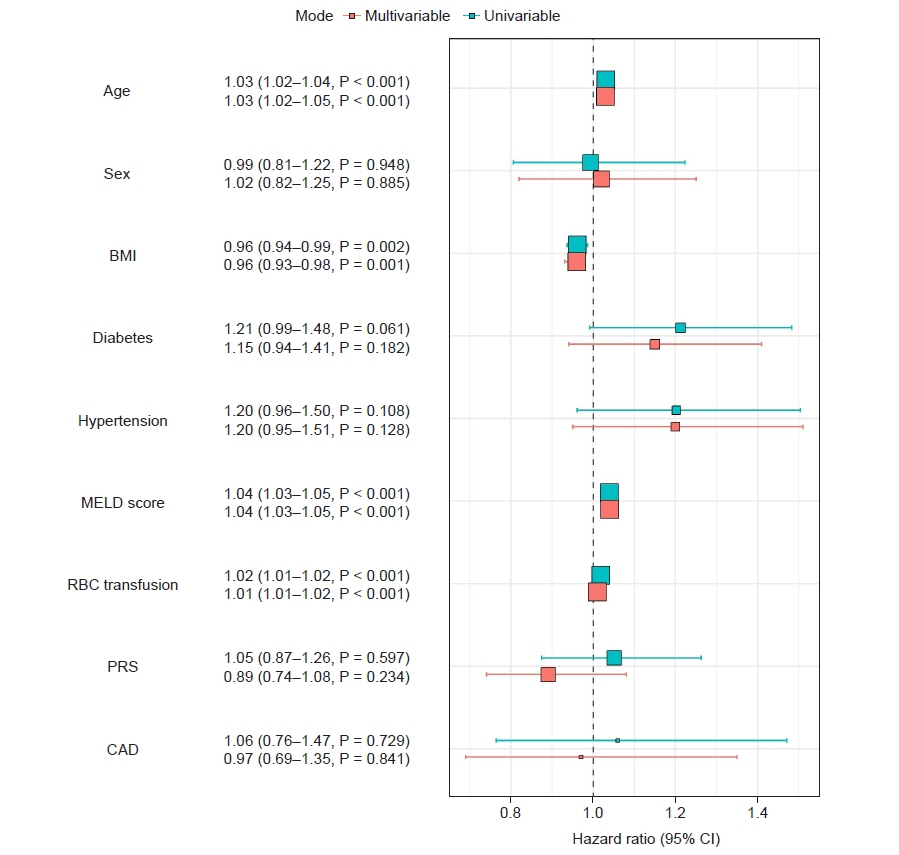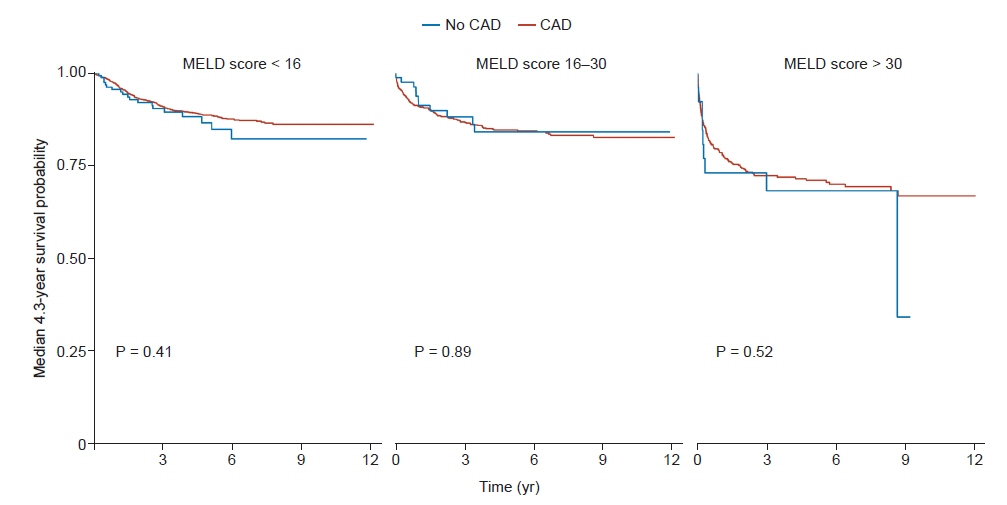Anesth Pain Med.
2022 Oct;17(4):404-411. 10.17085/apm.22167.
Temporary postoperative myocardial injury and long-term survival in liver transplant patients with coronary artery disease
- Affiliations
-
- 1Department of Anesthesiology and Pain Medicine, Laboratory for Cardiovascular Dynamics, Asan Medical Center, University of Ulsan College of Medicine, Seoul, Korea
- KMID: 2535339
- DOI: http://doi.org/10.17085/apm.22167
Abstract
- Background
Coronary artery disease (CAD) is increasing worldwide due to the aging population and cardiometabolic syndrome. However, the extent of postoperative myocardial injury, the most common cause of death during the 30 days after noncardiac surgery, remains unclear with respect to liver transplant (LT) patients with CAD. We examined the link between post-LT high sensitivity cardiac troponin I (hs_cTnI) and long-term survival according to liver disease severity.
Methods
Consecutive patients who underwent LT (n = 3,220) from 2010 to 2020 were evaluated retrospectively. CAD was defined as a history of coronary artery bypass surgery or percutaneous intervention, or previous myocardial infarction. Peak hs_cTnI levels within 30 days post-transplant were compared in patients with and without CAD. The primary endpoint was defined as an all-cause mortality at 12 years following LT. Secondary endpoints include peak hs_cTnI level within post-transplant 30 days and 30-day mortality. Survival analysis was performed using the Kaplan–Meier method.
Results
CAD patients (n = 264, 8.2%) had higher peak hs_cTnI levels within 30 days post-LT than those without CAD (median [interquartile]: 0.068 [0.030–0.154] vs. 0.087 [0.037–0.203] ng/ml, respectively; P = 0.004); however, the mortality rate was comparable (14.7% vs. 14.8%, respectively, P = 0.999), at 12 years, and 1.9% vs. 1.1% (P = 0.522) at 30 days, respectively, at 30 days. Subgroup analysis with stratified liver disease severity identified a similar risk of long-term mortality.
Conclusions
Although the peak hs_cTnI level within 30 days was higher in revascularized or treated CAD patients after LT compared those without CAD, long-term mortality rates at 12 years and 30-day mortality rate were comparable.
Figure
Reference
-
1. Xia VW, Taniguchi M, Steadman RH. The changing face of patients presenting for liver transplantation. Curr Opin Organ Transplant. 2008; 13:280–4.
Article2. VanWagner LB, Harinstein ME, Runo JR, Darling C, Serper M, Hall S, et al. Multidisciplinary approach to cardiac and pulmonary vascular disease risk assessment in liver transplantation: an evaluation of the evidence and consensus recommendations. Am J Transplant. 2018; 18:30–42.
Article3. Skaro AI, Gallon LG, Lyuksemburg V, Jay CL, Zhao L, Ladner DP, et al. The impact of coronary artery disease on outcomes after liver transplantation. J Cardiovasc Med (Hagerstown). 2016; 17:875–85.
Article4. Satapathy SK, Vanatta JM, Helmick RA, Flowers A, Kedia SK, Jiang Y, et al. Outcome of liver transplant recipients with revascularized coronary artery disease: a comparative analysis with and without cardiovascular risk factors. Transplantation. 2017; 101:793–803.
Article5. Mauermann E, Puelacher C, Lurati Buse G. Myocardial injury after noncardiac surgery: an underappreciated problem and current challenges. Curr Opin Anaesthesiol. 2016; 29:403–12.6. Writing Committee for the VISION Study Investigators, Devereaux PJ, Biccard BM, Sigamani A, Xavier D, Chan MTV, et al. Association of postoperative high-sensitivity troponin levels with myocardial injury and 30-day mortality among patients undergoing noncardiac surgery. JAMA. 2017; 317:1642–51.7. Costa MCDBG, Furtado MV, Borges FK, Ziegelmann PK, Suzumura ÉA, Berwanger O, et al. Perioperative troponin screening identifies patients at higher risk for major cardiovascular events in noncardiac surgery. Curr Probl Cardiol. 2021; 46:100429.
Article8. VanWagner LB, Lapin B, Levitsky J, Wilkins JT, Abecassis MM, Skaro AI, et al. High early cardiovascular mortality after liver transplantation. Liver Transpl. 2014; 20:1306–16.
Article9. Kwon HM, Moon YJ, Kim KS, Shin WJ, Huh IY, Jun IG, et al. Prognostic value of B-type natriuretic peptide in liver transplant patients: implication in posttransplant mortality. Hepatology. 2021; 74:336–50.
Article10. Moon YJ, Kwon HM, Jung KW, Jeong HW, Park YS, Jun IG, et al. Risk stratification of myocardial injury after liver transplantation in patients with computed tomographic coronary angiography-diagnosed coronary artery disease. Am J Transplant. 2019; 19:2053–66.
Article11. Park J, Lee SH, Han S, Kim KY, Kim GE, Park M, et al. Elevated high-sensitivity troponin I during living donor liver transplantation is associated with postoperative adverse outcomes. Transplantation. 2018; 102:e236–44.
Article12. Sessler DI, Devereaux PJ. Perioperative troponin screening. Anesth Analg. 2016; 123:359–60.
Article13. Kwon HM, Moon YJ, Jung KW, Park YS, Kim KS, Jun IG, et al. Appraisal of cardiac ejection fraction with liver disease severity: implication in post-liver transplantation mortality. Hepatology. 2020; 71:1364–80.
Article14. Kwon HM, Hwang GS. Cardiovascular dysfunction and liver transplantation. Korean J Anesthesiol. 2018; 71:85–91.
Article15. Zaky A, Bendjelid K. Appraising cardiac dysfunction in liver transplantation: an ongoing challenge. Liver Int. 2015; 35:12–29.
Article16. Raval Z, Harinstein ME, Skaro AI, Erdogan A, DeWolf AM, Shah SJ, et al. Cardiovascular risk assessment of the liver transplant candidate. J Am Coll Cardiol. 2011; 58:223–31.
Article17. Izzy M, VanWagner LB, Lin G, Altieri M, Findlay JY, Oh JK, et al. Cirrhotic Cardiomyopathy Consortium. Redefining cirrhotic cardiomyopathy for the modern era. Hepatology 2020; 71: 334-45. Erratum in: Hepatology. 2020; 72:1161.18. Lentine KL, Costa SP, Weir MR, Robb JF, Fleisher LA, Kasiske BL, et al. Cardiac disease evaluation and management among kidney and liver transplantation candidates: a scientific statement from the American Heart Association and the American College of Cardiology Foundation: endorsed by the American Society of Transplant Surgeons, American Society of Transplantation, and National Kidney Foundation. Circulation. 2012; 126:617–63.
Article19. Patel SS, Lin FP, Rodriguez VA, Bhati C, John BV, Pence T, et al. The relationship between coronary artery disease and cardiovascular events early after liver transplantation. Liver Int. 2019; 39:1363–71.
Article20. Barman PM, VanWagner LB. Cardiac risk assessment in liver transplant candidates: current controversies and future directions. Hepatology. 2021; 73:2564–76.
Article21. Tantai X, Liu Y, Yeo YH, Praktiknjo M, Mauro E, Hamaguchi Y, et al. Effect of sarcopenia on survival in patients with cirrhosis: a meta-analysis. J Hepatol. 2022; 76:588–99.
Article
- Full Text Links
- Actions
-
Cited
- CITED
-
- Close
- Share
- Similar articles
-
- Long Term Results of ST-Segment Elevation Myocardial Infarction versus Non-ST-Segment Elevation Myocardial Infarction after Off-Pump Coronary Artery Bypass Grafting: Propensity Score Matching Analysis
- Five-year all-cause mortality in critically ill liver transplant patients with coronary artery disease: analysis of acute-on chronic liver failure
- Two Cases of Multivessel Coronary Artery Ectasias Resulting in Acute Inferior Myocardial Infarction
- Long-term Survival after Coronary Artery bypass Surgery
- Study on the Platelet Survival Time in the Patients with Coronary Artery Disease

